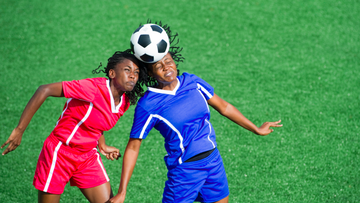Most of us are well aware of the rise in concussions and brain injuries in soccer, and how crippling they can be. However, an equally crippling albeit less life-threatening injury in soccer is hip pain and the injuries that cause it.
When you think about it, just about every action and skill you can think of in soccer rely on hip movements. If the hips are injured in any way, it will leave even the toughest players limping to the sidelines, unable to play until they find relief. And believe us when we say that hip injuries in soccer are quite common.
However, with a bit of knowledge, coaches can teach their players how to condition and protect themselves from painful hip injuries.
The Numbers on Hip Injuries in Soccer
Considering how physically demanding modern soccer is, athletes are at an elevated risk for hip injuries. There has been a multitude of studies examining hip and groin injuries in professional and youth soccer in European countries (with comparatively fewer studies that have involved American soccer).
The National Collegiate Athletic Association Injury Surveillance Program analyzed hip injury data for the 2004 to 2014 academic years for collegiate men's soccer. The study revealed that hip and groin injuries among collegiate male soccer players comprised most of new injuries with 87.8% of them being sustained in a non-contact manner.
The data also revealed that hip injuries were significantly more likely to occur during the pre-season, with 5.72 per 1000 athlete exposures. So yes, concussions are a big deal in soccer because of their long-term effects. However, hip injuries are far more a common nuisance to players’ wellbeing that needs to be addressed.
The Most Likely Hip Injuries to Affect Soccer Players
Like any sport, there are movement patterns that are intrinsic to soccer, meaning that certain actions will increase the risk of sustaining some hip injuries more than others. While it’s certainly possible for soccer players to suffer any type of hip (or lower-body injury), there are some common offenders, so-to-speak, that tend to afflict soccer players in particular. They include:
Practical Steps to Keep Hip Injuries at Bay
It’s not entirely possible to prevent hip injuries, but coaches and players themselves can take practical steps to greatly reduce their risk of getting injured. There’s no magic bullet solution to do so, however. It takes a combination of strategies to protect the hip joints from the stressors that could result in a painful, sidelining injury. Here at Storelli, we recommend three strategies in particular - wearing protective gear, soccer-specific condition and the avoidance of overtraining.
Hip injuries occur in part due to hard impacts, whether that be from hitting the ground after a header or getting tackled by an opponent. For these types of collisions, it’s important for players to protect themselves by reducing the force of these impacts.
They can do this by wearing padded goalie pants. For example, we offer a variety of such products ranging from padded goalie pants to padded sliders for youth, which are armored for the purpose of reducing impact forces.
Although padded soccer pants can reduce hip injuries, it’s also important for players to be conditioned against such injuries in the first place. The reality is that many players have underdeveloped core muscles and weak joints that simply can’t sustain the strenuous nature of modern soccer.
It’s important for players to incorporate conditioning exercises (and routines) that strengthen the hip flexors and hip joints. Adding these types of core exercises will help soccer players strengthen their midsections to withstand both hard impacts and also the continuous use of their hip joints and muscles.
Last but not least comes the issue of overtraining - an often overlooked yet all-too-common trigger of hip injuries. Players at all levels are spending more time on the pitch, whether that be in practices, regular-season games, tournaments and more. If players already have muscular imbalances in their hips, then playing more games will simply aggravate these weaknesses and lead to injuries over time.
That’s why it’s important for coaches and team management staff to rest players and be mindful of how many games their players are participating in during a season. More importantly, this should encourage coaches to reduce the amount of games certain players participate in where necessary.
Nipping Hip Injuries in the Bud
Soccer is a sport that places significant demands on the hip joints, and it’s important to keep hip joints and surrounding tissues healthy and protected. There are many unseen factors (ie. genetics, poor field conditions) that can lead to hip injuries, but coaches and players can reduce these risks. By incorporating the right mix of conditioning strategies and protective apparel, players can prevent troublesome hip injuries from keeping them on the bench.

